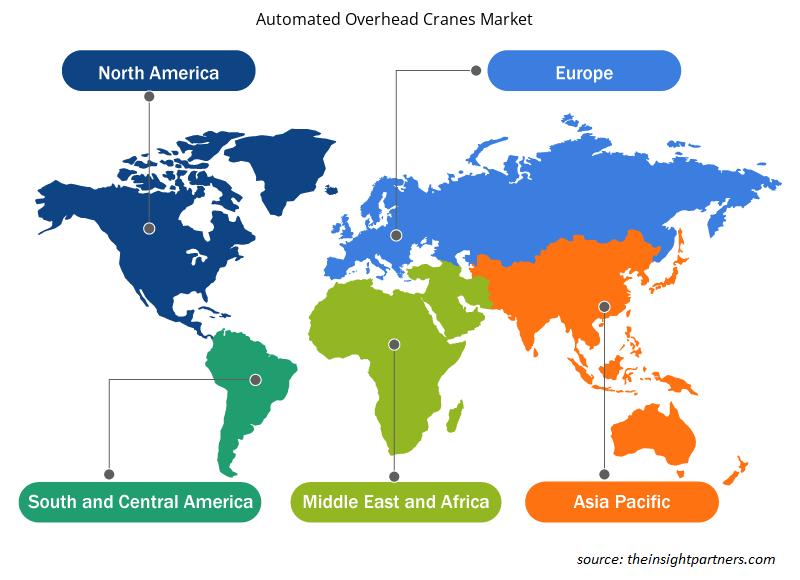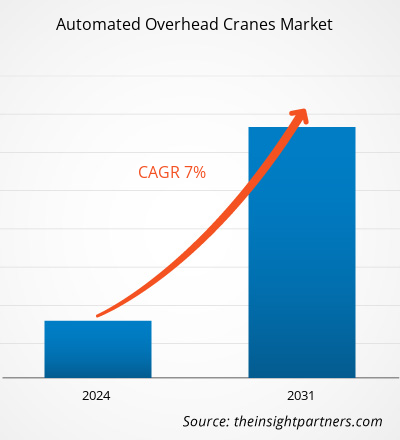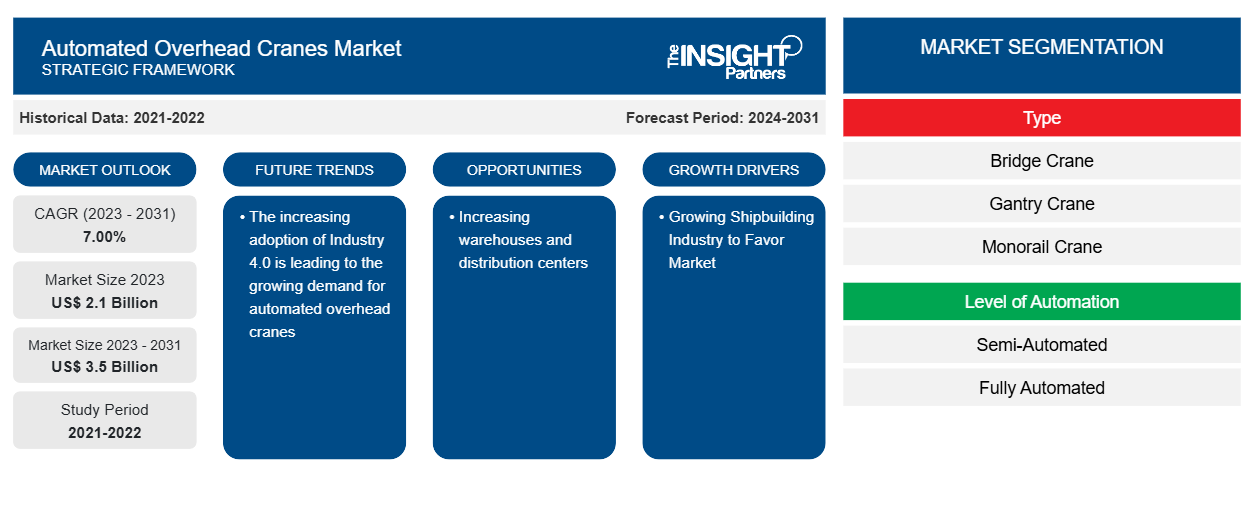La taille du marché des ponts roulants automatisés devrait atteindre 3,5 milliards USD d’ici 2031, contre 2,1 milliards USD en 2023. Le marché devrait enregistrer un TCAC de 7,00 % au cours de la période 2023-2031. L’adoption croissante de l’Industrie 4.0 entraîne une demande croissante de ponts roulants automatisés. Ces ponts roulants sont en outre mis en œuvre avec une technologie intelligente qui fournit des données pertinentes, ce qui contribue davantage au fonctionnement efficace de la technologie de l’Industrie 4.0. Une telle adoption de l’Industrie 4.0 devrait rester une tendance clé du marché.
Analyse du marché des ponts roulants automatisés
Les acteurs du marché des ponts roulants automatisés comprennent les fournisseurs de composants de ponts roulants automatisés, les fabricants de ponts roulants automatisés et les utilisateurs finaux. La présence d'un grand nombre de fournisseurs de composants, notamment de châssis de chariot , de câbles/cordes, de roues de pont, de palans, de rails de roulement et d'autres fabricants, permet aux fabricants de ponts roulants automatisés de répondre aux demandes de leurs clients respectifs. Les fournisseurs de composants de ponts roulants automatisés augmentent leurs capacités de production pour répondre à la demande croissante des fabricants de ponts roulants automatisés. Comme les fabricants de ponts roulants automatisés travaillent en permanence en synchronisation avec les fournisseurs de composants ainsi qu'avec les utilisateurs finaux, cela les aide à comprendre les demandes des utilisateurs finaux ainsi qu'à développer des composants avancés. Ils disposent également de divers distributeurs répartis dans divers pays et régions, qui fournissent également une assistance technique aux utilisateurs finaux.
Aperçu du marché des ponts roulants automatisés
Les acteurs de l'industrie sont assez sceptiques quant à l'investissement dans des solutions automatisées avancées qui impliquent un CAPEX initial élevé et des coûts associés à des mises à niveau et une maintenance constantes dans la dernière partie en raison de leurs contraintes budgétaires. Les industries qui adoptent des ponts roulants automatisés exigent à l'avance des fournisseurs de solutions bien formés et bien informés sur les subtilités de ses mises en œuvre, telles que le coût associé à la fabrication du pont roulant automatisé et à son renouvellement, à la maintenance, aux frais de service, à la formation et au conseil, entre autres. Étant donné que ces éléments sont très critiques pour une entreprise, même une petite pénurie peut entraîner un impact financier important. En outre, les propriétaires de petites et moyennes entreprises de différents secteurs industriels continuent de limiter la croissance du marché, en raison de leur budget limité pour les machines industrielles . En outre, le marché sensible aux prix, comme certains pays d'Asie et d'Afrique, devrait également influencer négativement l'adoption des ponts roulants automatisés, en raison de problèmes budgétaires et du manque de sensibilisation de son personnel industriel. Cela entrave ainsi la croissance du marché des ponts roulants automatisés à travers le monde.
Personnalisez ce rapport en fonction de vos besoins
Vous bénéficierez d'une personnalisation gratuite de n'importe quel rapport, y compris de certaines parties de ce rapport, d'une analyse au niveau des pays, d'un pack de données Excel, ainsi que de superbes offres et réductions pour les start-ups et les universités.
-
Obtenez les principales tendances clés du marché de ce rapport.Cet échantillon GRATUIT comprendra une analyse de données, allant des tendances du marché aux estimations et prévisions.
Facteurs moteurs et opportunités du marché des ponts roulants automatisés
La croissance de l'industrie de la construction navale devrait favoriser le marché
L'industrie de la construction navale est en pleine croissance en raison de l'augmentation du transport maritime. Selon les données publiées par l'Administration nationale des océans et de l'atmosphère en 2023, la construction de navires et de bateaux a connu un taux de croissance de 15 % par rapport à 2020. En outre, l'industrie chinoise de la construction navale et de bateaux a achevé la livraison de 38 millions de tonnes de port en lourd de navires et de bateaux, soit une croissance de 12 % par rapport à 2022. Une telle augmentation de l'industrie de la construction navale et de bateaux entraîne une demande accrue de ponts roulants automatisés, ce qui stimule finalement le marché.
Augmentation des entrepôts et des centres de distribution
Les détaillants en ligne sont désormais plus impatients d'ouvrir des entrepôts dans les villes de niveau II et III. Ainsi, la demande de ponts roulants automatisés dans les entrepôts et les centres de distribution pour le levage d'équipements lourds et la manutention des matériaux va augmenter. Le pont roulant d'entrepôt se compose généralement d'un pont roulant monopoutre, d'un pont roulant bipoutre et d'un portique de levage électrique pour les besoins de levage. La majorité des entrepôts et des centres de distribution utilisent des ponts roulants automatisés d'une capacité de levage de 1 tonne, 3 tonnes, 5 tonnes et 10 tonnes jusqu'à 100 tonnes.
Analyse de segmentation du rapport sur le marché des ponts roulants automatisés
Les segments clés qui ont contribué à l’élaboration de l’analyse du marché des ponts roulants automatisés sont le type, le niveau d’automatisation et l’industrie.
- En fonction du type, le marché des ponts roulants automatisés est divisé en ponts roulants, ponts roulants à portique, ponts roulants monorail, grues à flèche et autres. Le segment des ponts roulants détenait une part de marché plus importante en 2023.
- En fonction du niveau d'automatisation, le marché est segmenté en semi-automatisé et entièrement automatisé. Le segment semi-automatisé détenait la plus grande part du marché en 2023.
- En termes d'industrie, le marché est divisé en deux secteurs : la fabrication, la construction navale, les métaux et l'acier, etc. Le segment de la fabrication détenait une part importante du marché en 2023.
Analyse des parts de marché des ponts roulants automatisés par géographie
La portée géographique du rapport sur le marché des ponts roulants automatisés est principalement divisée en cinq régions : Amérique du Nord, Asie-Pacifique, Europe, Moyen-Orient et Afrique, et Amérique du Sud et centrale.
La région Asie-Pacifique domine le marché mondial des ponts roulants automatisés. L'Europe représente la deuxième plus grande part de marché. La Chine est devenue l'un des pôles de fabrication mondiaux. Ainsi, le pays est devenu l'un des principaux fournisseurs d'équipements à bas prix. En outre, l'industrie de la construction navale a connu une forte croissance au cours des dernières années, ce qui génère encore plus d'opportunités lucratives pour le marché.
Aperçu régional du marché des ponts roulants automatisés
Les tendances régionales et les facteurs influençant le marché des ponts roulants automatisés tout au long de la période de prévision ont été expliqués en détail par les analystes d’Insight Partners. Cette section traite également des segments et de la géographie du marché des ponts roulants automatisés en Amérique du Nord, en Europe, en Asie-Pacifique, au Moyen-Orient et en Afrique, ainsi qu’en Amérique du Sud et en Amérique centrale.

- Obtenez les données régionales spécifiques au marché des ponts roulants automatisés
Portée du rapport sur le marché des ponts roulants automatisés
| Attribut de rapport | Détails |
|---|---|
| Taille du marché en 2023 | 2,1 milliards de dollars américains |
| Taille du marché d'ici 2031 | 3,5 milliards de dollars américains |
| Taux de croissance annuel composé mondial (2023-2031) | 7,00% |
| Données historiques | 2021-2022 |
| Période de prévision | 2024-2031 |
| Segments couverts |
Par type
|
| Régions et pays couverts |
Amérique du Nord
|
| Leaders du marché et profils d'entreprises clés |
|
Densité des acteurs du marché : comprendre son impact sur la dynamique des entreprises
Le marché des ponts roulants automatisés connaît une croissance rapide, tirée par la demande croissante des utilisateurs finaux en raison de facteurs tels que l'évolution des préférences des consommateurs, les avancées technologiques et une plus grande sensibilisation aux avantages du produit. À mesure que la demande augmente, les entreprises élargissent leurs offres, innovent pour répondre aux besoins des consommateurs et capitalisent sur les tendances émergentes, ce qui alimente davantage la croissance du marché.
La densité des acteurs du marché fait référence à la répartition des entreprises ou des sociétés opérant sur un marché ou un secteur particulier. Elle indique le nombre de concurrents (acteurs du marché) présents sur un marché donné par rapport à sa taille ou à sa valeur marchande totale.
Les principales entreprises opérant sur le marché des ponts roulants automatisés sont :
- Systèmes automatiques
- Société Avon Barrier Ltée
- CAME SpA
- Houston System Inc.
- LA BARRIÈRE AUTOMATIQUE
- Systèmes de bornes automatisées MACS
Avis de non-responsabilité : les sociétés répertoriées ci-dessus ne sont pas classées dans un ordre particulier.

- Obtenez un aperçu des principaux acteurs du marché des ponts roulants automatisés
Actualités et développements récents du marché des ponts roulants automatisés
Le marché des ponts roulants automatisés est évalué en collectant des données qualitatives et quantitatives après des recherches primaires et secondaires, qui comprennent des publications d'entreprise importantes, des données d'association et des bases de données. Quelques-uns des développements du marché des ponts roulants automatisés sont répertoriés ci-dessous :
- EMH a lancé des portiques semi-pieds. Ces grues sont conçues pour transférer des matériaux entre les postes de travail. (Source : EMH, Newsletter, septembre 2023)
Rapport sur le marché des ponts roulants automatisés : couverture et livrables
Le rapport « Taille et prévisions du marché des ponts roulants automatisés (2021-2031) » fournit une analyse détaillée du marché couvrant les domaines ci-dessous :
- Taille et prévisions du marché des ponts roulants automatisés aux niveaux mondial, régional et national pour tous les segments de marché clés couverts dans le cadre
- Tendances du marché des ponts roulants automatisés ainsi que la dynamique du marché, comme les facteurs moteurs, les contraintes et les opportunités clés
- Analyse détaillée des cinq forces de Porter et SWOT
- Analyse du marché des ponts roulants automatisés couvrant les principales tendances du marché, le cadre mondial et régional, les principaux acteurs, les réglementations et les développements récents du marché
- Analyse du paysage industriel et de la concurrence couvrant la concentration du marché, l'analyse de la carte thermique, les principaux acteurs et les développements récents pour le marché des ponts roulants automatisés
- Profils d'entreprise détaillés
- Analyse historique (2 ans), année de base, prévision (7 ans) avec TCAC
- Analyse PEST et SWOT
- Taille du marché Valeur / Volume - Mondial, Régional, Pays
- Industrie et paysage concurrentiel
- Ensemble de données Excel
Rapports récents
Témoignages
Raison d'acheter
- Prise de décision éclairée
- Compréhension de la dynamique du marché
- Analyse concurrentielle
- Connaissances clients
- Prévisions de marché
- Atténuation des risques
- Planification stratégique
- Justification des investissements
- Identification des marchés émergents
- Amélioration des stratégies marketing
- Amélioration de l'efficacité opérationnelle
- Alignement sur les tendances réglementaires























 Obtenez un échantillon gratuit pour - Marché des ponts roulants automatisés
Obtenez un échantillon gratuit pour - Marché des ponts roulants automatisés